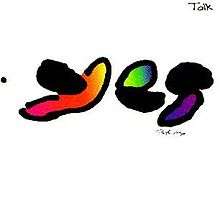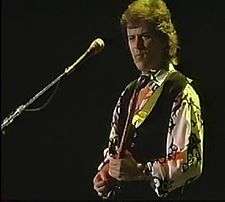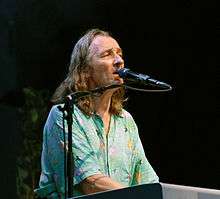Talk (Yes album)
| Talk | ||||
|---|---|---|---|---|
 | ||||
| Studio album by Yes | ||||
| Released | 21 March 1994 | |||
| Recorded | November 1992 – July 1993 | |||
| Studio | The Jacaranda Room, Los Angeles, California and A&M Recording Studios, Hollywood, California | |||
| Genre | Progressive rock | |||
| Length | 55:02 | |||
| Label | Victory Music | |||
| Producer | Trevor Rabin | |||
| Yes chronology | ||||
| ||||
| Singles from Talk | ||||
|
||||
Talk is the fourteenth studio album by the English progressive rock band Yes, released on 21 March 1994 by Victory Music, an independent label founded by former Atlantic Records vice president Phil Carson. Recording began in late 1992 with the line-up of Jon Anderson, Trevor Rabin, Chris Squire, Alan White, and Tony Kaye. Initially, Rick Wakeman was involved in the project before contractual problems led to his departure. The album was recorded on hard disk at Rabin's home studio using an early version of the digital audio workstation software Digital Performer.
Talk was a mild commercial success upon its release, reaching No. 20 in the UK and No. 33 in the U.S, and received a poor reception from music critics. "The Calling" and "Walls" were released as singles that charted at No. 3 and 24 on the U.S. Hot Mainstream Rock chart, respectively. The album was supported by a 1994 tour that covered North and South America and Japan. At its conclusion, Rabin and Kaye left the band in 1995. Carson has high praise for the album but thought it was made "at the wrong time".
Background

In March 1992, Yes completed their Union Tour which had eight band members on stage—singer Jon Anderson, bassist Chris Squire, guitarists Steve Howe and Trevor Rabin, drummers Bill Bruford and Alan White, and keyboardists Tony Kaye and Rick Wakeman. For the band's next project Phil Carson, a former Atlantic Records vice president and long time fan of the band, approached Rabin to produce a Yes album for Victory Music, an independent label he formed while he worked for JVC.[1] Carson wished for the album recorded with the 1983–88 line-up of Rabin, Anderson, Squire, White, Kaye, the same group that made Yes's two most commercially successful albums—90125 (1983) and Big Generator (1987).[2] As Rabin and Wakeman got on well during the Union tour, Carson suggested Wakeman be involved on the album.[2] Howe thought it was "silly" of Carson wanting to have Yes continue as a group minus Bruford and himself.[2] By mid-1993, Wakeman opted out due to management and contract issues.
After signing a record deal with Victory, work on Talk began with Rabin writing some "a lot" of material which he then developed with Anderson at a motel in San Clemente, California where Anderson had been staying. Rabin rented a room for "a week or two", working with just an acoustic guitar and two ghetto blasters for playing his demos and recording vocals.[2] This marked the first time since Anderson's return to Yes in 1983 where he was involved in the song writing from the beginning. On 90125 and Big Generator, he was involved at the later stages which limited his input.[3] Rabin spoke about the importance of working closely with Anderson this time round: "[On] 'Big Generator' ... I could feel the frustration in Jon that, although he was involved, it was basically me writing the songs and Jon trying to work on top of them ... So I realized, the best possible way is, if Jon's the singer, then I need to work real closely with him to provide him the best possible platform to sing on ... The two of us really worked hard as a team on it, which led to it being a better album for us".[2] Squire made sure to reduce his input in order to have Rabin and Anderson collaborate successfully, resulting in a reduction of writing credits; he was "very happy" with the material they wrote.[3]
Production
Recording

Talk was recorded and mixed at Rabin's home studio in Los Angeles, California, known as The Jacaranda Room.[lower-alpha 1] Additional recording was made at A&M Recording Studios in Hollywood.[4] Rabin took charge of the album's production, opting for digital non-linear recording techniques rather than traditional recording tape. His co-engineer Michael Jay linked four Apple Macintosh computers, each running the digital audio workstation software Digital Performer developed by Mark of the Unicorn. Rabin and Jay wrote notes on what fixes or new functions were needed to complete recording, and the software developers would write code to implement them.[5] Rabin stressed that the instruments heard on the album were "real" and feature live instrumentation, but recording them onto a hard drive allowed their sound to be manipulated more easily.[6] In its unedited form, the entire album took up over 3.4 GB of memory.[7] Production was delayed for a short while following the Northridge, California earthquake on 17 January 1994 to protect the equipment from damage caused by subsequent tremors.[7]
The album's cover was designed by German-American graphic artist Peter Max.[4][6] The album's sleeve contains the message: "dedicated to all Yes fans".[4][8]
Songs
"The Calling" developed and evolved around the song's introductory guitar riff. Rabin did not wish to make the song have a "preaching" message, but as a call for people to get together with one another.[3]
Rabin developed "I Am Waiting" with ease and little effort, taking him one day to put the music together. He remembered Anderson took an instant liking towards it, writing the lyrics and singing most of the vocals on the same day. Anderson singled out "I Am Waiting" as a favourite, described the song as "real pure music" because of the spontaneous way it was written.[9]
The music to "Real Love" was mainly written by Squire; Kaye described it as "pretty heavy".[10] The lyrics were partly inspired by Rabin's reading of A Brief History of Time by British physicist Stephen Hawking ("Far away in the depths of Hawking's mind...").[9]

"State of Play" originated from an incident with Rabin where an emergency services vehicle passed him with its siren on. He recalled about the sound of its siren: "I thought that's an amazing sound with the Doppler effect and everything as it goes by. That gave me the idea for the screeching kind of guitar sound in the beginning".[10] Speaking about its tune, Squire thought the track was a "conscious effort" from the band to combine a style of hip-hop "groove with heavy rock guitars".[10]
"Walls" was the last track produced for the album.[10] Rabin co-wrote the song with Supertramp vocalist Roger Hodgson, who declined an offer to be Yes's lead singer following Anderson's departure in 1988 following the Big Generator tour.[11] The pair recorded a demo in 1990 which was included on Rabin's demo compilation album 90124, released in 2003.
"Where Will You Be" is a song written by Rabin, originally as the signature tune to an Australian film.[10] He thought Anderson's lyrics were some of the best on Talk.[12] An instrumental version can be found on Rabin's 90124 demo album.
"Endless Dream" is a fifteen-minute track divided into three parts—"Silent Spring", "Talk", and "Endless Dream". The repeating piano riff at the beginning of "Silent Spring" came from a longer piece that Rabin intended to use as part of a film score, but chose to use it for the song instead. The piece then moves into a 15/8 time signature.[12] The instrumental section on "Talk" was originally a piece Rabin wrote for orchestra titled "October". Anderson said the song is "as good as anything" the band has done and noted "remarkable" structure of the "Endless Dream" section, rating it on par with "Close to the Edge" and "Awaken", two long Yes tracks from the 1970s.[12]
Release
On 16 March 1994, Yes held a Talk premier party broadcast hosted by Bob Coburn at the Hard Rock in Hollywood, California. This was followed by a release party broadcast on 21 March 1994, the day Talk was released. The album was a mild commercial success, reaching No. 20 in the UK and No. 33 in the US, their lowest charting album in the US since The Yes Album in 1971. Anderson and Rabin blamed the bankruptcy of the Victory label which caused a lack of promotion.[13] Two tracks were released as singles—"The Calling" and "Walls"; both peaked at No. 3 and 24 respectively on Billboard's Hot Mainstream Rock Tracks chart. Carson spoke of the album following its release: "[It] was probably one of the best albums they have ever done ... But of course it was totally at the wrong time. It sold around 300,000 around the world but nothing like that it should have done."[1][14]
In 1994, Yes released Yes Active, a CD-ROM containing the album and various interactive bonus material including interviews and band performances.
Talk was reissued in 2002 which combined "Endless Dream" into a single track and included "The Calling (Special Version)". In 2006, Talk was released as part of Yes's 2006 album compilation box set Essentially Yes on Eagle Records.
Critical reception
| Professional ratings | |
|---|---|
| Review scores | |
| Source | Rating |
| Allmusic | |
| Rolling Stone | |
Talk received a mostly negative response from critics. Rolling Stone rates the album with two stars out of five.[16] In his review for AllMusic, William Ruhlmann gave the same rating.[15] Musician magazine summarised a review for the album with "Shut up." Rabin spoke of its review: "I laughed at first ... But then I thought a review like that doesn't do anybody any good. We all get negative reviews of albums, and if the criticism is negative, and if it's constructive criticism, often it's something you can feed off".[17]
Tour
Talk was supported with a 1994 tour of North and South America and Japan. Rabin supervised the development of Concertsonics, a quadrophonic sound system that allowed people seated in selected seats to hear the concert's soundboard mix with headphones and personal radio by tuning into a specific FM frequency. Rabin was pleased with the band's performances, describing the tour as his "most satisfying" with the band.[18] The tour included a performance of "Walls" on Late Show with David Letterman on 20 June 1994. According to Rabin, host David Letterman "was driving one day and 'The Calling' ... came on the radio. He stopped the car and apparently called his producer to get the album".[17] In 1995, Rabin and Kaye decided to leave the band.
Track listing
Taken from the sleeve notes:[4]
| Side one | |||
|---|---|---|---|
| No. | Title | Writer(s) | Length |
| 1. | "The Calling" | Trevor Rabin, Jon Anderson, Chris Squire | 6:52 |
| 2. | "I Am Waiting" | Rabin, Anderson | 7:22 |
| 3. | "Real Love" | Rabin, Squire, Anderson | 8:42 |
| 4. | "State of Play" | Rabin, Anderson | 4:58 |
| Side two | |||
|---|---|---|---|
| No. | Title | Writer(s) | Length |
| 1. | "Walls" | Rabin, Roger Hodgson, Anderson | 4:52 |
| 2. | "Where Will You Be" | Rabin, Anderson | 6:03 |
| 3. | "Endless Dream: a.) Silent Spring (Instrumental)" | Rabin | 1:56 |
| 4. | "Endless Dream: b.) Talk" | Rabin, Anderson | 11:56 |
| 5. | "Endless Dream: c.) Endless Dream" | Rabin, Anderson | 1:50 |
| 2002 reissue | |||
|---|---|---|---|
| No. | Title | Writer(s) | Length |
| 7. | "Endless Dream"
| Anderson, Rabin, Squire | 15:43 |
| 8. | "The Calling (Special Version)" | Anderson, Rabin, Squire | 8:08 |
Personnel
Taken from the sleeve notes:[4]
Yes
- Jon Anderson – lead and backing vocals
- Trevor Rabin – electric and acoustic guitars, keyboards, programming, lead and backing vocals
- Tony Kaye – Hammond organ
- Chris Squire – bass guitar, backing vocals
- Alan White – drums
Production
- Trevor Rabin – production, engineering, mixing
- Michael Jay – engineering
- Stephen Marcussen – mastering
References
Notes
Citations
- 1 2 Welch 2008, p. 240.
- 1 2 3 4 5 Morse 1996, p. 98.
- 1 2 3 Morse 1996, p. 99.
- 1 2 3 4 5 Talk (Media notes). Victory Music. 1994. 828 489 2.
- ↑ Kirkman 2013, p. 105.
- 1 2 Welch 2008, p. 237.
- 1 2 Hague, David (October 1994). "Yes to Performer". Australian MacWorld Magazine.
- ↑ Welch 2008, p. 236.
- 1 2 Morse 1996, p. 100.
- 1 2 3 4 5 Morse 1996, p. 101.
- ↑ "Roger Hodgson collaboration represents road not taken for Yes: 'One of those things that fizzled out'". Something Else! Reviews. 25 December 2014.
- 1 2 3 Morse 1996, p. 102.
- ↑ http://somethingelsereviews.com/2014/05/10/it-was-a-perfect-storm-trevor-rabin-and-jon-anderson-remember-yes-most-overlooked-album/
- ↑ Welch 2008, p. 241.
- 1 2 Ruhlmann, William. "Yes: Talk". AllMusic. Retrieved 7 June 2015.
- 1 2 Birkbeck, Matt (22 September 1994). "Yes: Talk [Bonus Track]". Archived from the original on 18 December 2007.
- 1 2 Harry, Rich (19 June 1994). "Yes Uses The Latest Sound Techniques Affirmative Action". The Morning Call. Retrieved 4 June 2015.
- ↑ Iwasaki, Scott (3 July 1994). "YES IS JUMPING AS TOUR HEADS FOR S.L.". The Deseret News. Retrieved 4 June 2015.
Bibliography
- Kirkman, John (2013). Time and a Word: The Yes Interviews. Rufus Publications.
- Morse, Tim (1996). Yesstories: "Yes" in Their Own Words. St Martin's Press. ISBN 978-0-312-14453-1.
- Welch, Chris (2008). Close to the Edge – The Story of Yes. Omnibus Press. ISBN 978-1-84772-132-7.